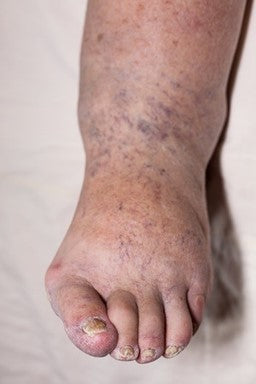Fungal nail infections are common infections of the fingernails or toenails that can cause the nail to become discolored, thick, and more likely to crack and break. Infections are more common in toenails than fingernails. The technical name for a fungal nail infection is “onychomycosis.” This is a local contraindication where the practitioner should not touch any part of the fungal infection or surrounding area.
Nails with a fungal infection are often:
- Thick & Discolored (yellow, brown, or white)
- Fragile or cracked
A fungal nail infection usually isn't painful unless it becomes severe. Some people who have fungal toenail infections also have a fungal skin infection on the foot.
Fungal nail infections can be caused by many different types of yeasts or molds that live in the environment. Small cracks in the nail or surrounding skin can allow these germs to enter and cause infection.[i]
The Mayo Clinic States: Fungal nail infection can develop in people at any age, but it's more common in older adults. As the nail ages, it can become brittle and dry. The resulting cracks in the nails allow fungi to enter. Other factors — such as reduced blood circulation to the feet and a weakened immune system — also may play a role.
Toenail fungal infection can start from athlete's foot (foot fungus), and it can spread from one nail to another, but it is uncommon to get an infection from someone else. [ii]
Despite the CDC and Mayo Clinic discounting nail fungus as highly contagious from person to person, bodyworkers who work with the hands and feet are at high risk for transmission. Nail fungus IS contagious from person to person, and more exposure creates more risk of infection or transmission. It’s important to avoid touching any fungal infection, keep your own hands clean and disinfect anything that contacts the fungus.
To learn more, please register for training at https://ceinstitute.com/
#massage #massagetherapy #massageprecautions #massagecontraindications
[i] National Center for Emerging and Zoonotic Infectious Diseases. “Fungal Diseases.” Centers for Disease Control and Prevention, 25 Jan. 2017, www.cdc.gov/fungal/nail-infections.html.
[ii] Mayo Clinic Staff. “Nail Fungus.” Mayo Clinic, Mayo Foundation for Medical Education and Research, 6 Mar. 2018, www.mayoclinic.org/diseases-conditions/nail-fungus/symptoms-causes/syc-20353294.


Laura Paola - December 16, 2025
I’m overjoyed to share my incredible journey with the amazing spell caster, Dr Peter, who helped me reunite with my boyfriend. My relationship was facing numerous challenges, and things got so bad that we ended up breaking up. I was heartbroken. I loved him more than anything. I cried endlessly until a friend of mine, who has a perfect relationship, shared her story and introduced me to the wonderful Dr Peter. He reassured me that everything would be fine and that no relationship is flawless, but he would help me fix mine. He guided me with specific steps, which I followed, and just 24 hours later, my boyfriend returned to me. I’m beyond thrilled! Thank you so much, Dr Peter! I’m leaving his contact information here so you can also benefit from his incredible work: You can reach him on WhatsApp. +2348162247974
Email. drpeterspellcaster21@gmail.com
Read more on his website
https://drpeterspellcaster.wixsite.com/my-site-1
julie F Anthony - September 07, 2025
Dear Brunoe Quick Hack Team,
I am writing to express my heartfelt gratitude for your exceptional service in recovering my scammed funds. As a surgeon and single mother of three, I was devastated by the loss of my savings to a trading scam.Website: BrunoeQuickHack.Com
Your team’s expertise and dedication were truly impressive. You worked tirelessly to track down the scammers and retrieve my money. Your professionalism and commitment to customer satisfaction are a testament to your company’s values. WhatsApp: +1-705-784-(2635)
I highly recommend your services to anyone who has fallen victim to a scam. Your help can make a significant difference in recovering lost funds and regaining financial stability. Email: Brunoequickhack@GMAIL.com
Thank you again for your outstanding work.
Sincerely,
Mrs. Julie F. Anthony
Rita Gliner - July 11, 2025
DO YOU REQUIRE TECHNICAL SKILLS TO SOLVE YOUR HACKING RELATED PROBLEMS?
●Hacking of all social media accounts
●Spying on cheating partner
●Retrieving of lost Cryptocurrency
●Data alteration
●Finding of lost phone
●Clearing/paying off of mortgage/loan
●Increasing of credit score
●Bitcoin mining
●Tracking of location
●Hacking of cell phone/other devices
●Block out or track down hackers
Secure yourself now!!!
Contact: cyberhelpdesk88@gmail.com
WhatsApp: +1 (209) 809-0176
Telegram: +1 (209) 809-0176
quatisha brown - April 07, 2025
I just want the whole world to know about this spell caster I met two weeks ago,I cannot say everything he has done for me and my family I was going through online when I meant this wonderful man’s testimony online how he won a lottery through the help of dr Ose I decided to just give it a try and my life is back to me now after i lost my job due to covid he gave me a winning numbers to play lottery and i won 5000usd for my first play since then i have been working with him and he has been giving me numbers to play my lottery i can not write everything he has done for me if you need a lottery spell today contact him on
Https://drosetemple.com oseremenspelltemple@gmail.com
quatisha brown - January 31, 2025
Https://drosetemple.com
oseremenspelltemple@gmail.com